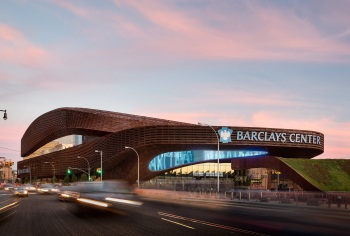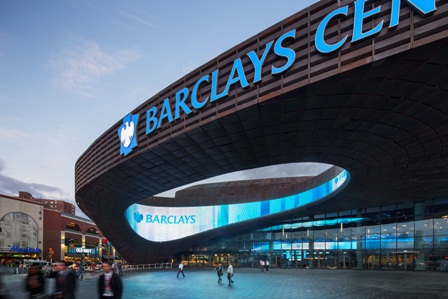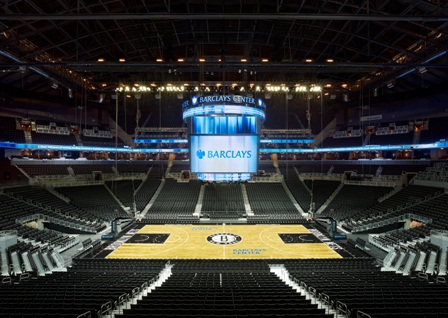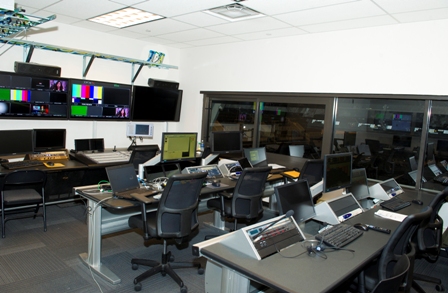IPTV at Heart of Barclays Center Stadium

The $1 billion Barclays Center Stadium, which opened on Sept. 21, is the home to the NBA Brooklyn Nets and NHL's New York Islanders. It can hold up to 19,000.
BROOKLYN, N.Y.—The new 18,200 seat Barclays Center, home to the NBA’s Brooklyn Nets and NHL’s New York Islanders, hosts the most advanced stadium audio/video system in the world. Among its features are 700 Sony HDTVs and about 100 concession stand digital message boards; every single one of them individually addressable by the stadium’s Cisco StadiumVision IPTV content distribution platform.
The same IPTV addressability extends to the Barclays Center outdoor Oculus LED marquee. Made by Daktronics, the Oculus is a 360-degree color marquee with 3,000 square feet of display space. Also connected to the Barlcays Center network is the Daktronics-built center-hung scoreboard, a four-sided, three-story tall unit with 3,550 square feet of LEDs, including four main LED displays measuring 16-feet by 27-feet each.
The Barclays Center outdoor Oculus LED marquee, built by Daktronix, is a 360-degree marquee with 3,000 square feet of display space. Add the rings of LED signs and two giant end-wall LED displays—nearly 8,000 square feet of LEDs in total—that encircle Barclays Center’s seating levels, and the amount of video landscape is huge. But again, what really makes the difference is that all of these displays have their own IP addresses, and thus the ability to be served individually with content.
“You can bring the addressability right down to wishing someone a ‘Happy Birthday’ within a specific executive box, on one specific display,” said Dave Potts, field systems engineer at Parsons Technology, which did the systems integration at Barclays Center. “The system offers that much control.”
The Daktronics-built center-hung scoreboard is a four-sided, three-story-tall unit with 3,550 square feet of LEDs, including four main LED displays measuring 16x27 feet each.IP DREAMS REALIZED
As stadium projects go, Barclays Center has been a long time coming. “The stadium was supposed to start in 2004 and open in 2006,” said Chip Foley, director of building technology with Forest City Ratner, the arena’s developer. “But we didn’t get to break ground until 2010, and open it until late September of this year.”
The delay may have had one benefit: It allowed Forest City Ratner to install the most advanced IPTV installation possible, using Cisco StadiumView and HD broadcast equipment supplied by Sony and Canon.
“My background is in networking technology,” explained Foley. As such, he wanted to bring the best of IP to bear to Barclays Center, and it shows
“Today, everything that runs here—not just IPTV, but security, point-of-sale and all other functions—runs on a single Cisco Connected Stadium intelligent network,” Foley said. “Granted, it is segmented into a number of secure virtual LANs; each supporting different levels of access control. But the fact remains that, with this technology, I can select a feed from any IP-connected camera and put it anywhere.”
As for the performance quality? “I’m an old RF guy, but this is my fourth IPTV installation, and I still can’t get over how well an IP-based system transports video,” said Potts. “There’s also the flexibility; I can specify not just which monitor the feed goes to, but even dedicate individual graphics and lower-third feeds for that screen only.”
ON THE CAPTAIN’S BRIDGE
All of Barclays Center’s amazing A/V capabilities are controlled in the Video Production Center (VPC). Unlike other such facilities that are hidden in the stadium basement, the VPC is mounted high up in the stands in a long, broad room, with windows that overlook the arena floor and seats. “I like to think of it as the ‘Captain’s Bridge,’” Foley quipped.
All of Barclays Center's A/V capabilities are controlled in the Video Production Center, mounted high up in the stands in a long, broad room, with windows that overlook the arean floor. Here, feeds from three Sony HD in-house cameras—one with a 75x Canon zoom lense—are mixed into a Sony MVS-7000X production switcher. (Two of the cameras are fixed; the third is a wireless handheld.) Other sources include satellite and Time Warner cable TV HD feeds; graphics generated both in-house and by the NBA; and various music sources that feed an awe-inspiring speaker setup. It includes six hanging arrays of 10 EAW KF740 enclosures and four EAW SB1001 subwoofers. All of this groundshaking audio power—a nod to the NBA’s hip-hop loving audience—is driven by 43 Lab.gruppen PLM 10000Q amplifiers with a combined output of 210,000 watts.
Barclays Center also provides free WiFi to all of its customers, supported by Cisco’s Connected Stadium WiFi system. As well, the arena is about to release a custom app that will allow fans to access video on their smartphones and iPads. “They can also use the app to order food at a concession stand, and have it ready to be picked up by the time they get there,” Foley said. To handle the expected wireless broadband traffic, Forest City Ratner has installed 275 WiFi hot spots and two 1 GB circuits.
With its astounding IPTV and digital content capabilities; its next-generation level of display addressability; and a music system that puts most, if not all, other arenas to shame, Barclays Center truly is the ‘Stadium of the Future’ made real today. As a result, other major league stadiums will likely have to follow Barclays Center’s A/V lead, if they want to stay competitive. Clearly, the bar has been raised.



Get the TV Tech Newsletter
The professional video industry's #1 source for news, trends and product and tech information. Sign up below.
James Careless is an award-winning journalist who has written for TV Technology since the 1990s. He has covered HDTV from the days of the six competing HDTV formats that led to the 1993 Grand Alliance, and onwards through ATSC 3.0 and OTT. He also writes for Radio World, along with other publications in aerospace, defense, public safety, streaming media, plus the amusement park industry for something different.

